Respected sir,
We have designed a bms with 6s configuration with MAX Bat voltage up to 25.2 V with important protection parameters configured are listed below:
COV : 4.2 V/cell
CUV : 1.8 V/cell
OCD : 2500 mA
OCC : 2000 mA
There is one problem I am accounting and I am confused and don't know how it works. Actually sir, I discharged my completely charged battery pack (all cells were balanced) while discharging there is cell 2 whose voltage come around 2.4 V while others cells were 3 to 3.2 V. I don't know how these happen if it discharge it should discharge in a balanced manner ( If I am correct ). Even CB was also not working to balance these cells, so I tried different ways so to see in which condition CB flags gets set. while doing these process my cell 2 voltage becomes < charging voltage and PV flag sets i.e my bms goes in precharge condition. After these when I started charging my battery pack PCHG flag got set and it was charging with 72 mA till it overcome voltage threshold. What I noticed that while charging my battery pack CB flag got set and it remains set till my battery pack got completely charged and they all were balanced.
Sir, i am attaching my schematic design, srec file as well as gg.csv file for your reference please review it and let me know if any changes required in that. Also, sir please guide me how I can learn these cell balancing concept in BMS as I can't understand it through technical reference manual and also when its parameter gets activated i.e during charging only or discharging or in both conditions.
Also, please specify is there any document which can explain about cell balancing and how its parameters behave in different conditions.
2437.BMS.pdfNEW_2.gg.csvGolden_Image_PDSG_set_PRECHG-3-26-2024.zip
Regards,
Shubham




